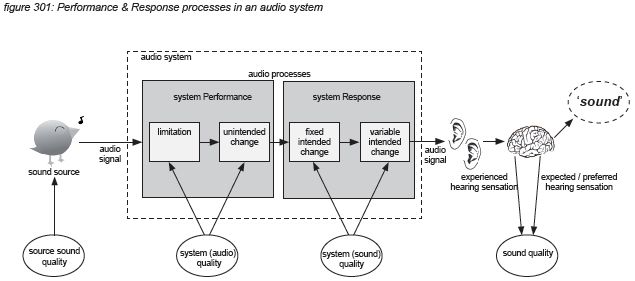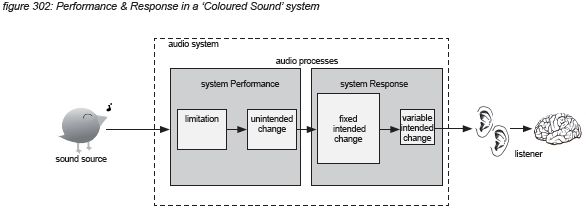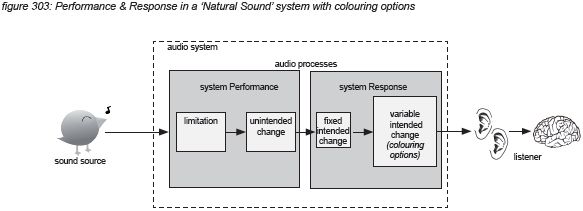3. Performance and Response
3.1 Unintended and Intended changes
The definitions and requirements for audio, sound and quality described in chapter 1 present two classes of processes in an audio system: those that unintentionally decrease the audio quality of the system (and with it the sound quality), and those that intentionally increase the sound quality of the system.
An ideal audio system will pass any signal in the audible range of the human auditory system in full, without limitation or unintentional change, offering fixed and variable processes that intentionally change the audio signal in order to increase the system’s sound quality. In real life however, audio systems always limit and unintentionally change signals within the audio universe - which means that the limitation and unintended changes can be heard by individuals listening to the system. By definition, limitation and unintended changes of audio signals decrease the sound quality because if such a limitation or change could be avoided, the product manufacturer / system designer would have done so. Also, if a limitation or unintended change would be found to increase the sound quality, we assume that the product manufacturer / system designer would redefine it as an intended change.
Intended changes posed to audio signals by a system’s processes by definition increase the sound quality - because if they would not increase the sound quality, the product or system designer would not have applied them in the system.
This arrangement seems logical, but it poses a philosophical problem: ‘Sound quality’ is a subjective parameter - every individual will assess sound quality differently. Therefore, the decision to designate a system process as intended or unintended change is subjective - different listeners might designate processes - eg. a signal path with a fixed EQ curve or a compression - differently: one listener might prefer the process, and the other might not.
To make the designation of processes in an audio system ‘semi-objective’, or at least properly defined, we propose to view the matter strictly from a manufacturer / system designer’s perspective, and define the decision method to designate system processes as unintended or intended change as follows:
audio system processes designated as unintended change
- all fixed processes that are listed by the product manufacturer / system designer without reference to a positive contribution to the product / system’s sound quality.
- all fixed processes not mentioned in the product manufacturer / system designer’s promotion or specification sheets.
audio system processes designated as intended change
- all variable processes.
- all fixed processes that are promoted by the product manufacturer / system designer in promotion or specification sheets as a positive contribution to the system’s sound quality.
Of course individual listeners can disagree with the decisions made by product manufacturers and system designers, differing in their preferences for individual processes in the audio system. Even when preferences are averaged, audiences for different genres of music (eg. pop, classical, jazz) might have different average preferences for an audio system’s process. To accommodate these differences, there are two design philosophies that product manufacturers and system designers can apply: ‘natural sound’ and ‘coloured sound’. To define these philosophies, first the concept of system Performance and system Response is presented.
3.2 Performance and Response
To identify quality issues in audio systems, two concepts are proposed to designate limitation and unintentional change as affecting a system’s audio quality, and fixed and variable intended change to affect a system’s sound quality:
Performance
A collection of system processes that limit and unintentionally change audio signals, in reference to an ideal audio system, representing how accurate the system passes audio.
Response
A collection of fixed and variable system processes that intentionally change audio signals, posing a positive contribution to the system’s sound quality.
Summarizing: a hearing sensation is invoked when an audio signal - generated by a sound source - reaches a listener through an audio system. The sound quality experienced by a listener depends on the source sound quality of the generated audio signal, limited and unintentionally changed by the Performance and intentionally changed by the Response of the audio system. This arrangement is equivalent to the formula presented in chapter 1.6.

Performance processes
limitations
noise floor in a signal chain. inability of a speaker system to reach 120dB at a listeners position. frequency bandwidth limitation of a speaker system.
unintended changes (always fixed)
distortion in a signal chain. damping factor in amp/speaker combinations. jitter level errors.
Response processes
intended fixed changes
EQ curve of a head amp, promoted as ‘warm sound’. passive crossover of a loudspeaker cabinet. fixed compressor and equalising in a speaker processor.
intended variable changes
a mixing console’s channel strip with gain, delay, EQ, compression. plug-in and outboard effects. graphic equalizers in speaker system processors.
3.3 Natural Sound and Coloured Sound
Audiences normally have no knowledge of the audio system in between the sound sources and their ears. For their assessment of sound quality - the degree of satisfaction of their individual hearing experience - they see the sound source and the audio system as one entity. For performances stored on media carriers (eg. CD, DVD, USB stick, hard disk), the play-out (‘HiFi’) system is recognised by consumers as a seperate system affecting sound quality, but the system used for producing the content (eg. music studio equipment) is not recognised separately.
Normally only ‘audio professionals’ distinguish the full audio system from the sound source(s) as a separate entity affecting audio quality. Audio professionals include product manufacturers engineers, system designers and sound engineers operating audio systems.
Most audio professionals will agree that the Performance of a system should be as high as possible, offering low noise floors, low distortion, high output, high bandwidth etc.
On the Response of systems however, the opinion of audio professionals differ. For products specially designed for a genre of applications, manufacturers and system designers sometimes apply fixed Response processes in systems because they are generally required for that particular application genre - eg. ‘warm’ sounding head amps for pop music. For products and systems designed to serve a variety of applications, the Response processes are offered as variable parameters, transferring the decision to use them - and in what degree - to the sound engineer operating the audio system.
With the increasing complexity of projects, and also the increased focus of investors and artists on a system’s sound quality and the sound engineer’s creativity, there is an increasing demand for a systems with a natural sound default response - maximally respecting the ‘natural’ sound characteristics of the sound source through a high system Performance to retain the sonic qualities of the audio signal as it was generated by the sound source as much as possible. All system Response processes are then available as colouring tools - allowing sound engineers to freely ‘shape’ the system’s sound to suit the project’s creative goals.
In general, for manufacturers and system designers it is more costly to offer variable Response processes than fixed Response processes because of the extra connectivity and user interface facilities required for variable processes. If the ‘warm sounding pre-amp’ is offered to the sound engineer as a variable process, it needs additional switching and control circuitry (either analogue or digital), and a user interface (eg. knobs or a touch screen GUI) to control them - which is more costly than offering the process in a fixed form. With the increased processing power of digital mixing consoles, many Response processes are now offered to the sound engineer as ‘plugin’ units, available to be inserted in any signal chain in the system. In general, digital (networked) systems offer much more variability of the process parameters compared to analogue systems, but there are still many differences in variability between digital systems as a result of design philosophy and application genre target.
Using the Performance and Response concept, sound systems can be categorized as ‘coloured sound’ and ‘natural sound’ systems. In the below figures, the amount of fixed and variable processing is represented by the size of the Response process blocks:


Coloured Sound systems are easy to operate as they already provide a default Response matching the application genre. Coloured Sound systems can be set up quickly because many Response processes have been set already by the product manufacturer or system designer. However, the fixed processes are designed to support a particular application genre. The downside is that if a fixed process mismatches with the application, it can not be turned off - the sound engineer and his audience are stuck with it.
Natural Sound systems can be applied for any genre, giving the sound engineer more control over processes to influence sound quality in more detail compared to coloured sound systems. All variable intended processes are available as colouring tools. The downside is that the sound engineer has to do more work to control all variable Response processes. Also, the sound engineer has to have additional knowledge and experience to be able to control these processes properly.
Both design philosophies can offer the same Performance (audio quality) and Response (sound quality), the choice for an investment or hire depends on the requirements of the application genres, time constraints, and the abilities of the available sound engineers to operate the audio system.






